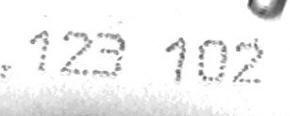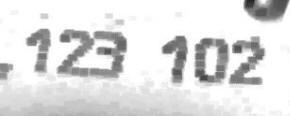Application Specific Systems:
• Wood Product Inspection Systems
•
Printing & Finish Inspection Systems
• Metal Part Inspection Systems
• Thread Analysis & Inspection Systems
• Bearing Assembly Inspection Systems
• Bearing Race Inspection Systems
• Automotive Control Arm Inspection System
• Manifold & Crossover Inspection Systems
• Assembly Inspection Systems
• Battery Inspection Systems
• Tablet, Capsule, and Pill Inspection Systems
• Circuit Board Component Assembly Inspection Systems
• Packaged Liquid Product Inspection Systems
• Caps & Closures Inspection Systems
• Gravity Belt Thickener Controls
• Ultra-Accurate Automatic Gauging Systems
Needle-Stamped Digits on Metal
In this sample application, we present the possibilities opened by the template matching functionality added to NeuroCheck after version 4.0.
 Needle-stamped characters are often used to mark on metal parts, because of their robustness. Unlike, for example, ink-jet characters they are very hard to remove
again and easily survive subsequent manufacturing processes and the rough environmental conditions in metal-working factories. Unfortunately they are also hard to
recognize for an image processing system, because they tend to disintegrate into single points instead of contiguous, unbroken lines.
Needle-stamped characters are often used to mark on metal parts, because of their robustness. Unlike, for example, ink-jet characters they are very hard to remove
again and easily survive subsequent manufacturing processes and the rough environmental conditions in metal-working factories. Unfortunately they are also hard to
recognize for an image processing system, because they tend to disintegrate into single points instead of contiguous, unbroken lines.
There are two ways to solve this problem:
- Use a morphological filter, erosion or opening in this case, to widen the individual needle-marks until the lines become unbroken.
 This approach causes several problems. First of all morphological filter processes tend to be quite time-consuming. Furthermore, as can be seen in the image below,
the "2" and "3" in the above image will easily be fused together by the filtering process. Although NeuroCheck allows you to define highly specialized filter kernels
adapted to the geometry of specific image structures, there would be a very difficult tradeoff between the requirements of the different structures appearing in
characters.
This approach causes several problems. First of all morphological filter processes tend to be quite time-consuming. Furthermore, as can be seen in the image below,
the "2" and "3" in the above image will easily be fused together by the filtering process. Although NeuroCheck allows you to define highly specialized filter kernels
adapted to the geometry of specific image structures, there would be a very difficult tradeoff between the requirements of the different structures appearing in
characters.  Use template matching. It searches for objects within an image based on the similarity of image regions to predefined templates. You can easily define templates
tailored to your application by presenting some typical images to NeuroCheck and indicating the template patterns using the mouse, as shown in the image below.
NeuroCheck will then search for a specified number of patterns in the image exhibiting a minimum similarity to the defined templates.
Use template matching. It searches for objects within an image based on the similarity of image regions to predefined templates. You can easily define templates
tailored to your application by presenting some typical images to NeuroCheck and indicating the template patterns using the mouse, as shown in the image below.
NeuroCheck will then search for a specified number of patterns in the image exhibiting a minimum similarity to the defined templates.
 Despite the obvious differences in the appearance of the digits, a single template per digit class proves to be sufficient to detect all digits reliably, as in the
next image. Recognizing the precisely located digits is then no problem at all.
Despite the obvious differences in the appearance of the digits, a single template per digit class proves to be sufficient to detect all digits reliably, as in the
next image. Recognizing the precisely located digits is then no problem at all.


